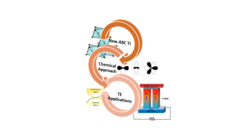Marie Curie Fellow
Federico Miguel Serrano Sanchez
Project: Topological Chemistry in Ternary Compounds
In 2005, Kane and Mele extended Duncan Haldane’s model (Nobel Prize of physics, 2016) to graphene[1], describing a new topological invariant and related electronic gapless-edge states. This invariant is connected to the fundamental differences that distinguish non-trivial from trivial insulators and lays the groundwork of the field of topological materials. Since then, intensive research activity has been focused on condensed matter and materials science. However, the understanding of topological electronic structure from a chemical view is still deficient. [2–4]

This project addresses the experimental study of new materials predicted as topological insulators within the group of ABC Nowotny-Juza and REME ternary phases, and the connection between the chemical features in their crystalline and surface structures with the topological character in momentum-space. Accordingly, it is developed in three interrelated stages: 1) growth of high-quality single crystals; 2) structural characterization and relation between topological electronic structure and chemical concepts; 3) manipulation of electronic structure aiming at thermoelectric applications.
Hence, high-quality single crystals with selected composition are grown by suitable methods. The Fermi level is tuned by chemical doping or controlling the intrinsic defects to observe the topological physics. Subsequently, a detailed bulk and surface structural characterization is performed. The electronic structure of a material in the reciprocal space can be linked to chemical concepts in real space, such as chemical bonding, electronegativity differences, orbital overlap, etc. A systematic study of the crystalline bulk and surface structures performed by Synchrotron and low energy electron diffraction, and X-ray absorption near the edge, will aim at the relation between chemical concepts and the electronic structure of selected topological materials.
Finally, based on the understanding of the relation between chemical concepts and electronic structure, the thermoelectric transport properties of these novel ABC topological insulators will be investigated and optimized for thermoelectric applications.
This project is funded by the MSCA-IF No.839821 and the results' dissemination will deepen the understanding of topological chemistry and stimulate the technological application of topological materials.
[1] C. L. Kane, E. J. Mele, Phys. Rev. Lett. 2005, 95, 146802.
[2] B. Yan, C. Felser, Annu. Rev. Condens. Matter Phys. 2017, 8, 337.
[3] B. Bradlyn, L. Elcoro, J. Cano, M. G. Vergniory, Z. Wang, C. Felser, M. I. Aroyo, B. A. Bernevig, Nature 2017, 547, 298.
[4] L. M. Schoop, F. Pielnhofer, B. V Lotsch, Chem. Mater. 2018, 30, 3155.
Living and working in Dresden
Dresden is the capital city of Saxony, built surrounding the river Elbe. It may offer all the hustle and bustle of a great city or the quietness of a small town. It presents a huge cultural background many entertainment activities that enrich life in the city. More importantly, Dresden gathers one of the largest scientific communities in Germany, formed of many technological companies and research institutions together with the Technical University of Dresden, in which many renowned scientists have thrived. The Max Planck Institute for Chemical Physics of Solids (MPI CPfS) is located next to the TU-Dresden campus. Research activities at the CPfS ranges from solid state chemistry to condensed matter and theoretical physics, being an interdisciplinary environment where all kinds of material science researchers work on their projects. It offers an intercultural and open-minded atmosphere with employees from many different regions around the world, and provides all the benefits that come along with the enrollment in a German institution.
The solid-state chemistry group (SSC), directed by Prof. Dr. Claudia Felser, has yielded outstanding work on material science over the last years. The scope of the group includes the rational design of new materials for energy and spintronics applications, as topological insulators, thermoelectric materials and superconductors. The group is formed of several post-docs and PhD students coming from many different universities from all over the world, and is divided and managed by experienced group leaders, each one focused on different fields of research. It makes a great environment for researchers willing to learn and exploit new scientific knowledge on the cutting edge of topological materials. Additionally, the group provides many networking opportunities, as it has established numerous collaborations with other research groups to complement the investigation.
Marie-Sklodowska Curie Actions
Marie Skłodowska-Curie Actions are EU funded grants provided to support researchers at any career stage, of any age and nationality. They are oriented to positively impact the future prospects of the applicants by promoting interdisciplinary research and new collaborations between different groups. Knowledge exchange is one of the main points of the actions, as is ensuring mobility between countries. Moreover, they encourage outreach activities, by including funding for scientific events in the endeavor of making science visible and available to a broader public.
There are different types of MSC Actions that depend on the proposed goal. The MSCA Individual Fellowship allow researchers to operate a project at a host institution, boosting their qualifications and expanding their scientific skills. It enhances the mobility and focus on the personal and academic training of the researcher.

